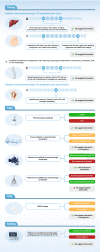Saudi Critical Care Society clinical practice guidelines on the prevention of venous thromboembolism in adults with trauma: reviewed for evidence-based integrity and endorsed by the Scandinavian Society of Anaesthesiology and Intensive Care Medicine
- PMID: 37165105
- PMCID: PMC10172441
- DOI: 10.1186/s13613-023-01135-8
Saudi Critical Care Society clinical practice guidelines on the prevention of venous thromboembolism in adults with trauma: reviewed for evidence-based integrity and endorsed by the Scandinavian Society of Anaesthesiology and Intensive Care Medicine
Abstract
Background: To develop evidence-based clinical practice guidelines on venous thromboembolism (VTE) prevention in adults with trauma in inpatient settings.
Methods: The Saudi Critical Care Society (SCCS) sponsored guidelines development and included 22 multidisciplinary panel members who completed conflict-of-interest forms. The panel developed and answered structured guidelines questions. For each question, the literature was searched for relevant studies. To summarize treatment effects, meta-analyses were conducted or updated. Quality of evidence was assessed using the Grading Recommendations, Assessment, Development, and Evaluation (GRADE) approach, then the evidence-to-decision (EtD) framework was used to generate recommendations. Recommendations covered the following prioritized domains: timing of pharmacologic VTE prophylaxis initiation in non-operative blunt solid organ injuries; isolated blunt traumatic brain injury (TBI); isolated blunt spine trauma or fracture and/or spinal cord injury (SCI); type and dose of pharmacologic VTE prophylaxis; mechanical VTE prophylaxis; routine duplex ultrasonography (US) surveillance; and inferior vena cava filters (IVCFs).
Results: The panel issued 12 clinical practice recommendations-one, a strong recommendation, 10 weak, and one with no recommendation due to insufficient evidence. The panel suggests starting early pharmacologic VTE prophylaxis for non-operative blunt solid organ injuries, isolated blunt TBIs, and SCIs. The panel suggests using low molecular weight heparin (LMWH) over unfractionated heparin (UFH) and suggests either intermediate-high dose LMWH or conventional dosing LMWH. For adults with trauma who are not pharmacologic candidates, the panel strongly recommends using mechanical VTE prophylaxis with intermittent pneumatic compression (IPC). The panel suggests using either combined VTE prophylaxis with mechanical and pharmacologic methods or pharmacologic VTE prophylaxis alone. Additionally, the panel suggests routine bilateral lower extremity US in adults with trauma with elevated risk of VTE who are ineligible for pharmacologic VTE prophylaxis and suggests against the routine placement of prophylactic IVCFs. Because of insufficient evidence, the panel did not issue any recommendation on the use of early pharmacologic VTE prophylaxis in adults with isolated blunt TBI requiring neurosurgical intervention.
Conclusion: The SCCS guidelines for VTE prevention in adults with trauma were based on the best available evidence and identified areas for further research. The framework may facilitate adaptation of recommendations by national/international guideline policymakers.
Keywords: Adult trauma patient; GRADE; Low molecular weight heparin; Non-operative solid organ injuries; Pharmacologic VTE prophylaxis; Practice guidelines; Spinal cord injury; Traumatic brain injury; Unfractionated heparin; Venous thromboembolism.
© 2023. The Author(s).
Conflict of interest statement
Yaseen Arabi is the principal investigator for US Screening trial (DETECT-NCT05112705), PREVENT trial (NCT02040103) and PREVENT sub-study. The remaining authors declare that they have no competing interests (Additional file 3: Appendix 3).
Figures

Similar articles
-
Prophylaxis and treatment of venous thromboembolism in patients with cancer: the Saudi clinical practice guideline.Ann Saudi Med. 2015 Mar-Apr;35(2):95-106. doi: 10.5144/0256-4947.2015.95. Ann Saudi Med. 2015. PMID: 26336014 Free PMC article.
-
Prevention of VTE in nonorthopedic surgical patients: Antithrombotic Therapy and Prevention of Thrombosis, 9th ed: American College of Chest Physicians Evidence-Based Clinical Practice Guidelines.Chest. 2012 Feb;141(2 Suppl):e227S-e277S. doi: 10.1378/chest.11-2297. Chest. 2012. PMID: 22315263 Free PMC article.
-
Venous thromboembolism, thrombophilia, antithrombotic therapy, and pregnancy: American College of Chest Physicians Evidence-Based Clinical Practice Guidelines (8th Edition).Chest. 2008 Jun;133(6 Suppl):844S-886S. doi: 10.1378/chest.08-0761. Chest. 2008. PMID: 18574280
-
Venous Thromboembolism Chemoprophylaxis in Trauma and Emergency General Surgery Patients: A Systematic Review.J Trauma Nurs. 2021 Sep-Oct 01;28(5):323-331. doi: 10.1097/JTN.0000000000000606. J Trauma Nurs. 2021. PMID: 34491950
-
Surgical venous thromboembolism prophylaxis: clinical practice update.Hosp Pract (1995). 2020 Dec;48(5):248-257. doi: 10.1080/21548331.2020.1788893. Epub 2020 Aug 1. Hosp Pract (1995). 2020. PMID: 32589468 Review.
Cited by
-
Traumatic Brain Injury in Patients under Anticoagulant Therapy: Review of Management in Emergency Department.J Clin Med. 2024 Jun 24;13(13):3669. doi: 10.3390/jcm13133669. J Clin Med. 2024. PMID: 38999235 Free PMC article. Review.
-
Traumatic brain injury management in the intensive care unit: standard of care and knowledge gaps.Intensive Care Med. 2025 Jun;51(6):1112-1127. doi: 10.1007/s00134-025-07967-1. Epub 2025 Jun 16. Intensive Care Med. 2025. PMID: 40522481 Review.
-
Meta-Analysis Investigating Optimal Timing of Chemoprophylaxis for Venous Thromboembolism in Operatively Managed Blunt Spinal Injuries.Int J Spine Surg. 2024 Nov 15;18(6):731-7. doi: 10.14444/8656. Online ahead of print. Int J Spine Surg. 2024. PMID: 39547678 Free PMC article.
References
-
- World Health Organization . Global health estimates 2016: deaths by cause, age, sex, by country and by region, 2000–2016. Geneva: WHO; 2018.
-
- Rappold JF, Sheppard FR, Carmichael SP, II, Cuschieri J, Ley E, Rangel E, et al. Venous thromboembolism prophylaxis in the trauma intensive care unit: an American Association for the Surgery of Trauma Critical Care Committee Clinical Consensus Document. Trauma Surg Acute Care Open. 2021;6:e000643. doi: 10.1136/tsaco-2020-000643. - DOI - PMC - PubMed
Publication types
LinkOut - more resources
Full Text Sources

